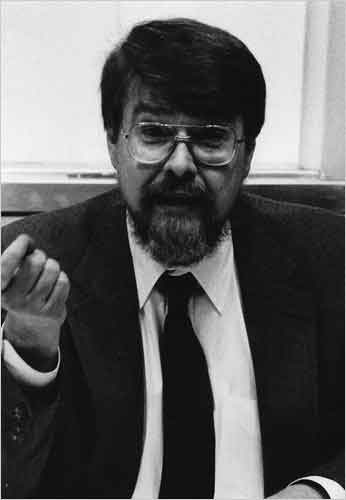David Rumelhart Dies at 68; Created Computer Simulations of Perception
David E. Rumelhart, whose computer simulations of perception gave scientists some of the first testable models of neural processing and proved helpful in the development of machine learning and artificial intelligence, died Sunday in Chelsea, Mich. He was 68.

David Rumelhart
The cause was complications of Pick’s disease, an Alzheimer’s-like disorder from which he had suffered for more than a decade, his son Karl said.
When Dr. Rumelhart, a psychologist, began thinking in the 1960s about how neurons process information, the field was split into two camps that had little common language: biologists, who focused on neurons and brain tissue; and cognitive psychologists, who studied far more abstract processes, like reasoning skills and learning strategies.
By starting small — showing, for instance, that the brain’s ability to recognize a single letter was greatly influenced by the letters around it — Dr. Rumelhart and his colleague Jay McClelland, around 1980, built computer programs that roughly simulated perception. Later, he devised an algorithm that allowed computer programs to learn how to perceive. Using his program, a computer could interpret underwater sonar signals with roughly the accuracy that a person could. It was an important early step in machine learning, a critical component in artificial intelligence.
Working at the University of California, San Diego, he eventually developed a simulation of how three or more layers of neurons could work together to process information — as is required for the brain to engage in any complex task, like reading. Previous models were far cruder. In a landmark 1986 paper, written with Geoffrey Hinton and Ronald Williams for the journal Nature, he described how the system worked.
Dr. McClelland, director of the Center for Mind, Brain and Computation at Stanford, said the neural processing work “led to extremely powerful systems for doing things like visual object recognition and handwritten character classification.” In 1986, he and Dr. Rumelhart wrote a book, “Parallel Distributed Processing,” that became a central text in the field.
In their work Dr. Rumelhart and Dr. McClelland argued that language, like most knowledge, relies mainly on memory and is represented in the brain by sets of associations between elements of sound and meaning.
This put them in opposition with scientists who argue that the brain generates some words by using rules shaped in part by brain biology — for example, adding “-ed” to a stem to form a past tense.
“Rumelhart was enormously important in the 1980s in reviving this neural network approach to language and cognition,” said Steven Pinker, a psychologist at Harvard and a leading proponent of the rival “rules” theory.
Even though they sometimes disagreed, Dr. Pinker said that Dr. Rumelhart’s computer simulations “prompted me and many others to ask very fruitful questions, and that in the end is about all a good scientist can ask for.”
David Everett Rumelhart was born on June 6, 1942, in Wessington Springs, S.D., the eldest of three sons born to Everett, a printer, and Thelma, a librarian. He graduated from the University of South Dakota in 1963 with a degree in psychology and math and completed his Ph.D. at Stanford in 1967.
He spent 20 years on the faculty of the University of California, San Diego, before returning to Stanford in 1987. He retired from Stanford in 1998, when the symptoms of Pick’s disease became disabling, and moved in with his brother Donald in Ann Arbor, Mich.
In addition to his brother Donald and his son Karl, his survivors include another son, Peter; another brother, Roger; and four grandsons. His marriage to Marilyn Austin ended in divorce.
Dr. Rumelhart won a number of professional awards, including a MacArthur fellowship and the American Psychological Association’s Distinguished Scientific Contribution Award.
He also had one named after him: the David E. Rumelhart Prize, a $100,000 award given annually by the Glushko-Samuelson Foundation to any individual or team making a contribution to the “theoretical foundations of human cognition.”
This article has been revised to reflect the following correction:
Correction: March 22, 2011
An obituary on Saturday about the psychologist David E. Rumelhart misstated the year that the book “Parallel Distributed Processing,” which he wrote with Jay McClelland, was published. It was 1986, not 1987.
A version of this article appears in print on March 19, 2011, on page D8 of the New York edition with the headline: David E. Rumelhart, 68, Who Simulated Perception.
www.psychspace.com心理学空间网
